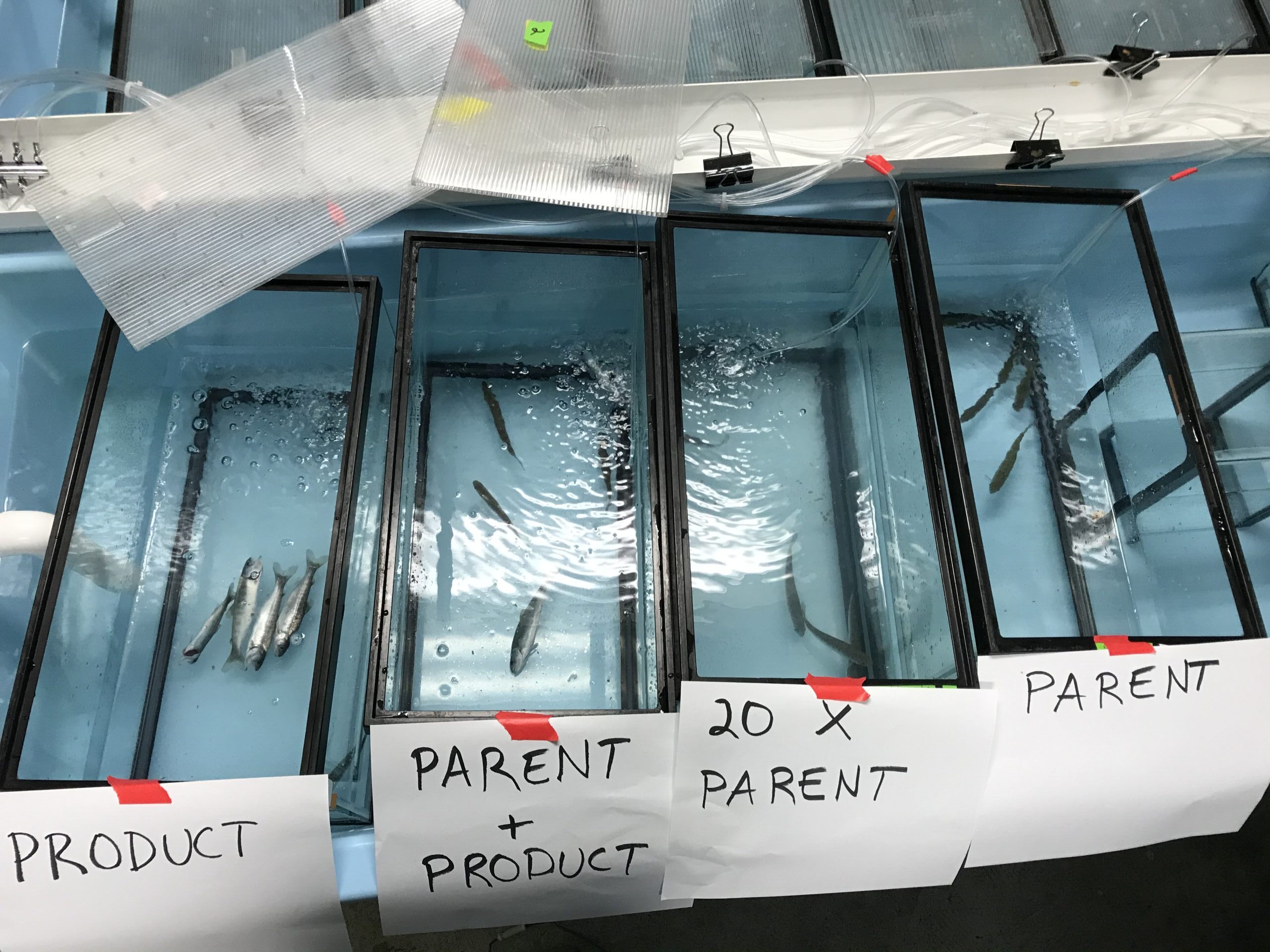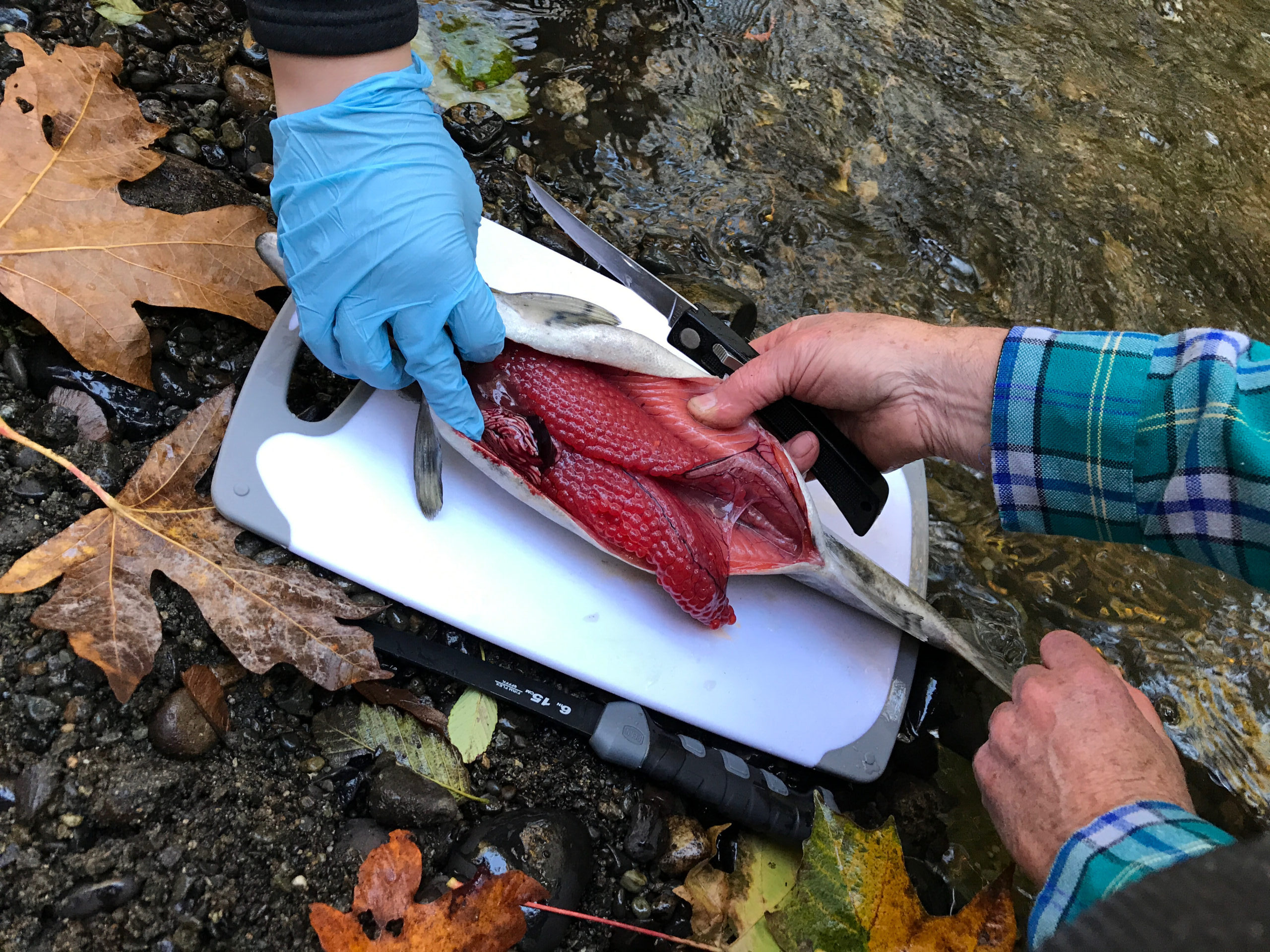Coho mass die-offs caused by tire chemical underscores growing impacts of urbanization on Pacific salmon
March 4, 2022In a nutshell
- In recent years mortality rates of pre-spawning coho salmon in some watersheds in Washington state have periodically spiked during summer and fall
- Previous analyses revealed links between episodic mass die-offs and precipitation across an urbanization gradient, pointing to a toxicant carried in stormwater runoff as the cause; further research implicated vehicle tires as the probable source
- In this study, comprehensive testing of tire-related chemicals determined that 6PPD-quinone, a transformation product of the tire protectant 6PPD, is lethal to coho salmon at concentrations common in urban streams following rainstorms
- Mitigating the toxic effects of 6PPD-quinone and other non-point source pollutants in urban streams will require development of chemical alternatives and improving treatment of stormwater runoff through implementation of green infrastructure, such as rain gardens
- The results of this study highlight the gauntlet of challenges, including exposure to an increasing array of chemical pollutants, that salmon in urban freshwater systems must overcome
In some years, up to 90% of adult coho salmon returns fail to reach spawning grounds in waterways coursing through the developed areas ringing Puget Sound. Initially, it was assumed that the die-offs were due to a familiar cause – changes in environmental conditions, pathogens, known toxins – but it quickly became apparent that the more obvious sources were not to blame. As the mystery deepened, scientists began to turn their suspicion toward the possibility of a previously undetected agent.
A key breakthrough came in 2017, in the form of a spatial analysis of 51 coho spawning sites across the greater Puget Sound Basin performed by Feist et al. (2017). The analysis revealed that coho mortality rates were linked to both precipitation and higher levels of urban development. Construction of a predictive risk map depicting pre-spawning adult mortality suggested that death rates were high enough to raise concerns about coho sustainability in ~40% of Puget Sound watersheds, and that mortality risk tracked the rural-to-urban gradient.
Particularly notable was the strong correlation detected between coho mortality events and two factors associated with increasing urbanization, road density and traffic intensity. When considered in tandem with the link between mass die-offs and precipitation, the relationship between higher coho mortality and vehicles suggested that a chemical contaminant transported into streams via stormwater runoff was responsible for killing adult coho.
Building on the work of Feist et al. and others, scientists further narrowed the search through non-target chemical analyses of potential sources associated with automobiles, from which it was determined that the chemistry of water samples that had been in direct contact with tires closely matched that of water collected from streams during die-off events. Lab experiments further demonstrated that solutions containing tire-particle leachate were especially toxic to coho.
Although it was now evident that rubber shed from tires was the ultimate source of the deadly compound, isolating the specific chemical responsible from the hundreds in tires – as well as the countless combinations, byproducts, and derivatives thereof – remained a formidable undertaking.
That challenge was taken up by Tian et al. (2021), who, through a painstaking process of elimination and deductive reasoning, eventually determined that a previously unknown compound called 6PPD-quinone – a quinone-analog transformation product of N-phenyl-N’-(1,3-dimethylbutyl)-p-phenylenediamine, better known as 6PPD – is poisonous to adult coho.
An effective antiozonant, 6PPD is often incorporated into synthetic and natural rubber products – everything from rubber hoses to the soles of sneakers – to inhibit ozone-related degradation, as ozone weakens the chemical bonds keeping rubber intact. Antiozonants slow rubber breakdown by essentially running interference, reacting with ozone before it can interact directly with the rubber. In tires, exposure to ozone can lead to premature cracking and heat-associated aging that reduce tire stability and durability, and thus 6PPD extends tire life, improving performance and safety.
When 6PPD comes into contact with ozone, however, it fragments into several different chemical derivatives, one of which is 6PPD-quinone. Subsequent lab testing by Tian et al. showed conclusively that this derivative is toxic to coho salmon at concentrations commonly found in streams following rainfall.

Experimental design included multiple tanks with varying fractions of the tire leachate to test which tank was the most deadly to juvenile coho (Photo by Zhenyu Tian)
How exactly 6PPD-quinone kills coho is not yet known, nor why it has comparatively little effect on other salmonids; chum salmon, for example, use many of the same streams around Seattle and spawn at around the same time, yet appear to be far less sensitive to 6PPD-quinone.
But researchers involved in the study caution that this apparent discrepancy in response among different salmonids may be misleading.
“We are learning more about the pathophysiology in coho, which we hope will lead to a mechanistic understanding of the toxicant’s action in other species,” explains Jenifer McIntyre, an aquatic toxicologist at Washington State University. “No other salmonids have been directly tested with the new chemical, but we certainly see sensitivity in other species to roadway runoff. Whether that sensitivity is due to 6PPD-quinone has yet to be determined.”
Given the density of automobiles in urban areas, it came as no surprise that water samples collected from salmon-bearing rivers and streams around cities in northern California were also found to contain 6PPD-quinone, an indication of its ubiquity. Moreover, the continuing expansion of roads and highways along the length of the Pacific Coast will expose more watersheds to 6PPD-quinone and other chemicals, putting additional salmon populations at risk.
The growing threat human pollutants pose to salmon health highlights the urgent need for development of mitigation and management strategies that address the impacts of non-point source pollution on both freshwater ecosystems and on salmon directly.

Documented pre-spawn mortality in coho salmon at Longfellow Creek in the Seattle area. (Photo by Zhenyu Tian)
“Finally,” she adds, “we should replace 6PPD in tires with an antiozonant that doesn’t transform into a toxic chemical.”
Ending use of 6PPD in tires would seem to be the most straightforward solution, but for now at least, tire manufacturers are non-committal about switching to an alternative preservative. In a statement released in December 2020 in response to the study’s findings, the US Tire Manufacturers Association – a national trade and advocacy group that includes the major tire-making companies in the US – merely acknowledged that “6PPD has been studied” before adding that “not enough is yet known about the newly discovered transformation product, 6PPD-quinone” to warrant immediate removal of the compound from tires.
Industrial and commercial contaminants are an especially prevalent hazard in urban waterways, but the impacts of development extend beyond higher levels of pollution; salmon in city streams must also contend with highly modified channel structure, exaggerated flow regimes, blocked fish passages, and a greater variety and abundance of non-native species, among numerous other obstacles.
Yet there is little doubt that the increasing diversity, complexity, and concentration of non-point source pollutants pose a particularly distinctive threat to freshwater organisms in areas undergoing widespread urban development.
“The question is, what other species are being affected by 6PPD-quinone and related chemicals in the environment throughout the world?” McIntyre wonders. “6PPD-quinone is just one chemical produced from a product that most of us use on a regular basis. We need to take greater care with our product use and development to protect environmental health, including our own.”
Science Spotlight by Ken Ferguson
References
Feist BE, Buhle ER, Baldwin DH, et al. 2017. Roads to ruin: conservation threats to a sentinel species across an urban gradient. Ecol Appl 27: 2382–96.
